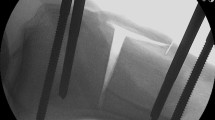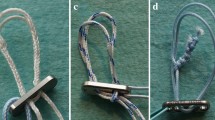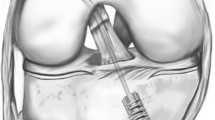Abstract
Purpose
There is a lack of objective evidence investigating how previous non-augmented ACL suture repair techniques and contemporary augmentation techniques in ACL suture repair restrain anterior tibial translation (ATT) across the arc of flexion, and after cyclic loading of the knee. The purpose of this work was to test the null hypotheses that there would be no statistically significant difference in ATT after non-, static- and dynamic-augmented ACL suture repair, and they will not restore ATT to normal values across the arc of flexion of the knee after cyclic loading.
Methods
Eleven human cadaveric knees were mounted in a test rig, and knee kinematics from 0° to 90° of flexion were recorded by use of an optical tracking system. Measurements were recorded without load and with 89-N tibial anterior force. The knees were tested in the following states: ACL-intact, ACL-deficient, non-augmented suture repair, static tape augmentation and dynamic augmentation after 10 and 300 loading cycles.
Results
Only static tape augmentation and dynamic augmentation restored ATT to values similar to the ACL-intact state directly postoperation, and maintained this after cyclic loading. However, contrary to dynamic augmentation, the ATT after static tape augmentation failed to remain statistically less than for the ACL-deficient state after cyclic loading. Moreover, after cyclic loading, ATT was significantly less with dynamic augmentation when compared to static tape augmentation.
Conclusion
In contrast to non-augmented ACL suture repair and static tape augmentation, only dynamic augmentation resulted in restoration of ATT values similar to the ACL-intact knee and decreased ATT values when compared to the ACL-deficient knee immediately post-operation and also after cyclic loading, across the arc of flexion, thus allowing the null hypotheses to be rejected. This may assist healing of the ruptured ACL. Therefore, this study would support further clinical evaluation of dynamic augmentation of ACL repair.




(reprinted with permission of Stephen et al. [35])





Similar content being viewed by others
References
Ateschrang A, Ahmad SS, Stockle U, Schroeter S, Schenk W, Ahrend MD (2017) Recovery of ACL function after dynamic intraligamentary stabilization is resultant to restoration of ACL integrity and scar tissue formation. Knee Surg Sports Traumatol Arthrosc. https://doi.org/10.1007/s00167-017-4656-x
Buchler L, Regli D, Evangelopoulos DS, Bieri K, Ahmad SS, Krismer A et al (2016) Functional recovery following primary ACL repair with dynamic intraligamentary stabilization. Knee 23:549–553
Cuomo P, Rama KR, Bull AM, Amis AA (2007) The effects of different tensioning strategies on knee laxity and graft tension after double-bundle anterior cruciate ligament reconstruction. Am J Sports Med 35:2083–2090
Eggli S, Roder C, Perler G, Henle P (2016) Five year results of the first ten ACL patients treated with dynamic intraligamentary stabilisation. BMC Musculoskelet Disord 17:105
Engebretsen L, Lew WD, Lewis JL, Hunter RE (1989) Knee mechanics after repair of the anterior cruciate ligament. A cadaver study of ligament augmentation. Acta Orthop Scand 60:703–709
Evangelopoulos DS, Kohl S, Schwienbacher S, Gantenbein B, Exadaktylos A, Ahmad SS (2015) Collagen application reduces complication rates of mid-substance ACL tears treated with dynamic intraligamentary stabilization. Knee Surg Sports Traumatol Arthrosc. https://doi.org/10.1007/s00167-015-3838-7
Faul F, Erdfelder E, Lang AG, Buchner A (2007) G*Power 3: a flexible statistical power analysis program for the social, behavioral, and biomedical sciences. Behav Res Methods 39:175–191
Fisher MB, Jung HJ, McMahon PJ, Woo SL (2010) Evaluation of bone tunnel placement for suture augmentation of an injured anterior cruciate ligament: effects on joint stability in a goat model. J Orthop Res 28:1373–1379
Fisher MB, Jung HJ, McMahon PJ, Woo SL (2011) Suture augmentation following ACL injury to restore the function of the ACL, MCL, and medial meniscus in the goat stifle joint. J Biomech 44:1530–1535
Fleming BC, Carey JL, Spindler KP, Murray MM (2008) Can suture repair of ACL transection restore normal anteroposterior laxity of the knee? An ex vivo study. J Orthop Res 26:1500–1505
Friederich NF, Muller W, O’Brien WR (1992) [Clinical application of biomechanic and functional anatomical findings of the knee joint]. Orthopade 21:41–50
Heitmann M, Dratzidis A, Jagodzinski M, Wohlmuth P, Hurschler C, Puschel K et al (2014) Ligament bracing-augmented cruciate ligament sutures: biomechanical studies of a new treatment concept. Unfallchirurg 117:650–657
Henle P, Roder C, Perler G, Heitkemper S, Eggli S (2015) Dynamic Intraligamentary Stabilization (DIS) for treatment of acute anterior cruciate ligament ruptures: case series experience of the first three years. BMC Musculoskelet Disord 16:27
Inderhaug E, Stephen JM, Williams A, Amis AA (2017) Biomechanical comparison of anterolateral procedures combined with anterior cruciate ligament reconstruction. Am J Sports Med 45:347–354
Khadem R, Yeh CC, Sadeghi-Tehrani M, Bax MR, Johnson JA, Welch JN et al (2000) Comparative tracking error analysis of five different optical tracking systems. Comput Aid Surg 5:98–107
Kiapour AM, Murray MM (2014) Basic science of anterior cruciate ligament injury and repair. Bone Joint Res 3:20–31
Kohl S, Evangelopoulos DS, Ahmad SS, Kohlhof H, Herrmann G, Bonel H et al (2014) A novel technique, dynamic intraligamentary stabilization creates optimal conditions for primary ACL healing: a preliminary biomechanical study. Knee 21:477–480
Kohl S, Evangelopoulos DS, Kohlhof H, Hartel M, Bonel H, Henle P et al (2013) Anterior crucial ligament rupture: self-healing through dynamic intraligamentary stabilization technique. Knee Surg Sports Traumatol Arthrosc 21:599–605
Kohl S, Evangelopoulos DS, Schar MO, Bieri K, Muller T, Ahmad SS (2016) Dynamic intraligamentary stabilisation: initial experience with treatment of acute ACL ruptures. Bone Joint J 98-B:793–798
Kohn D, Busche T, Carls J (1998) Drill hole position in endoscopic anterior cruciate ligament reconstruction. Results of an advanced arthroscopy course. Knee Surg Sports Traumatol Arthrosc 6(Suppl 1):S13–15
Kondo E, Yasuda K, Azuma H, Tanabe Y, Yagi T (2008) Prospective clinical comparisons of anatomic double-bundle versus single-bundle anterior cruciate ligament reconstruction procedures in 328 consecutive patients. Am J Sports Med 36:1675–1687
Kosters C, Herbort M, Schliemann B, Raschke MJ, Lenschow S (2015) Dynamic intraligamentary stabilization of the anterior cruciate ligament. Operative technique and short-term clinical results. Unfallchirurg 118:364–371
Krismer AM, Gousopoulos L, Kohl S, Ateschrang A, Kohlhof H, Ahmad SS (2017) Factors influencing the success of anterior cruciate ligament repair with dynamic intraligamentary stabilisation. Knee Surg Sports Traumatol Arthrosc 25:3923–3928
Lewis JL, Lew WD, Schmidt J (1988) Description and error evaluation of an in vitro knee joint testing system. J Biomech Eng 110:238–248
Mackay GM, Blyth MJ, Anthony I, Hopper GP, Ribbans WJ (2015) A review of ligament augmentation with the InternalBrace: the surgical principle is described for the lateral ankle ligament and ACL repair in particular, and a comprehensive review of other surgical applications and techniques is presented. Surg Technol Int 26:239–255
Marshall JL, Rubin RM (1977) Knee ligament injuries—a diagnostic and therapeutic approach. Orthop Clin North Am 8:641–668
Marshall JL, Warren RF, Wickiewicz TL, Reider B (1979) The anterior cruciate ligament: a technique of repair and reconstruction. Clin Orthop Relat Res 97–106
Meister M, Koch J, Amsler F, Arnold MP, Hirschmann MT (2017) ACL suturing using dynamic intraligamentary stabilisation showing good clinical outcome but a high reoperation rate: a retrospective independent study. Knee Surg Sports Traumatol Arthrosc. https://doi.org/10.1007/s00167-017-4726-0
Murray MM, Fleming BC (2013) Biology of anterior cruciate ligament injury and repair: Kappa delta ann doner vaughn award paper 2013. J Orthop Res 31:1501–1506
Murray MM, Flutie BM, Kalish LA, Ecklund K, Fleming BC, Proffen BL et al (2016) The bridge-enhanced anterior cruciate ligament repair (BEAR) procedure: an early feasibility cohort study. Orthop J Sports Med 4:2325967116672176
Murray MM, Spindler KP, Abreu E, Muller JA, Nedder A, Kelly M et al (2007) Collagen-platelet rich plasma hydrogel enhances primary repair of the porcine anterior cruciate ligament. J Orthop Res 25:81–91
Radford WJ, Amis AA, Heatley FW (1994) Immediate strength after suture of a torn anterior cruciate ligament. J Bone Joint Surg Br 76:480–484
Schliemann B, Glasbrenner J, Rosenbaum D, Lammers K, Herbort M, Domnick C et al (2017) Changes in gait pattern and early functional results after ACL repair are comparable to those of ACL reconstruction. Knee Surg Sports Traumatol Arthrosc. https://doi.org/10.1007/s00167-017-4618-3
Schliemann B, Lenschow S, Domnick C, Herbort M, Haberli J, Schulze M et al (2015) Knee joint kinematics after dynamic intraligamentary stabilization: cadaveric study on a novel anterior cruciate ligament repair technique. Knee Surg Sports Traumatol Arthrosc. https://doi.org/10.1007/s00167-015-3735-0
Stephen JM, Halewood C, Kittl C, Bollen SR, Williams A, Amis AA (2016) Posteromedial meniscocapsular lesions increase tibiofemoral joint laxity with anterior cruciate ligament deficiency, and their repair reduces laxity. Am J Sports Med 44:400–408
van der List JP, DiFelice GS (2017) Role of tear location on outcomes of open primary repair of the anterior cruciate ligament: a systematic review of historical studies. Knee 24:898–908
van Eck CF, Limpisvasti O, ElAttrache NS (2017) Is there a role for internal bracing and repair of the anterior cruciate ligament? A systematic literature review. Am J Sports Med. https://doi.org/10.1177/0363546517717956363546517717956
Vavken P, Fleming BC, Mastrangelo AN, Machan JT, Murray MM (2012) Biomechanical outcomes after bioenhanced anterior cruciate ligament repair and anterior cruciate ligament reconstruction are equal in a porcine model. Arthroscopy 28:672–680
Wilson WT, Hopper GP, Byrne PA, MacKay GM (2016) Anterior cruciate ligament repair with internal brace ligament augmentation. Surg Technol Int XXIX:273–278
Zavras TD, Race A, Bull AM, Amis AA (2001) A comparative study of ‘isometric’ points for anterior cruciate ligament graft attachment. Knee Surg Sports Traumatol Arthrosc 9:28–33
Funding
No outside funding was received for the conduct of this study.
Author information
Authors and Affiliations
Contributions
RAGH, RW and AAA have made substantial contributions to conception and design of the study. RAGH, RW and JMS have made substantial contributions to acquisition of data. All authors have made substantial contributions to analysis and interpretation of data, and have been involved in drafting the manuscript and revising it critically for important intellectual content. All authors have given final approval of the version to be published and agree to be accountable for all aspects of the work in ensuring that questions related to the accuracy or integrity of any part of the work are appropriately investigated and resolved.
Corresponding author
Ethics declarations
Conflict of interest
The authors declare that they have no conflict of interest.
Ethical approval
The local Institutional Review Board (IRB: Imperial College Healthcare Tissue Bank, London, UK; IRB Nr. R17007) approved this study.
Informed consent
No informed consent statements were applicable.
Rights and permissions
About this article
Cite this article
Hoogeslag, R.A.G., Brouwer, R.W., Huis in ‘t Veld, R. et al. Dynamic augmentation restores anterior tibial translation in ACL suture repair: a biomechanical comparison of non-, static and dynamic augmentation techniques. Knee Surg Sports Traumatol Arthrosc 26, 2986–2996 (2018). https://doi.org/10.1007/s00167-018-4848-z
Received:
Accepted:
Published:
Issue Date:
DOI: https://doi.org/10.1007/s00167-018-4848-z




